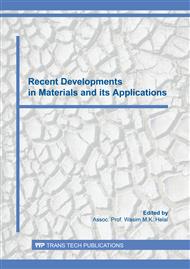[1]
Lee, Y-K., S-J. Lee, and Jeongho Han. Critical assessment 19: stacking fault energies of austenitic steels., (2016): 1-8.
Google Scholar
[2]
Bronz, A., et al. Structure and strength cast high aluminum and manganese of iron alloys with a high carbon content. In: Machines, Technolgies, Materials 9o International Congress, Varna, Bulgaria. (2012). pp.36-37. .
Google Scholar
[3]
Lee, P. Y., et al. High temperature oxidation resistance of Fe-Mn-Al alloys at 600° C., High Temperature Materials and Processes 10.3 (1992): 141-144.
DOI: 10.1515/htmp.1992.10.3.141
Google Scholar
[4]
Shih, S. T., C. Y. Tai, and T. P. Perng. Corrosion behavior of two-phase Fe-Mn-Al alloys in 3.5% NaCl solution., Corrosion 49.2 (1993): 130-134.
DOI: 10.5006/1.3299207
Google Scholar
[5]
Saxena, Vikas Kumar, et al. Fatigue and fracture behavior of a nickel-chromium free austenitic steel., International journal of pressure vessels and piping 60.2 (1994): 151-157. .
DOI: 10.1016/0308-0161(94)90021-3
Google Scholar
[6]
Zhu, X. M., and Y. S. Zhang. Investigation of the electrochemical corrosion behavior and passive film for Fe-Mn, Fe-Mn-Al, and Fe-Mn-Al-Cr alloys in aqueous solutions., Corrosion 54.1 (1998): 3-12.
DOI: 10.5006/1.3284826
Google Scholar
[7]
Herrmann, J., G. Inden, and G. Sauthoff. Deformation behaviour of iron-rich iron-aluminum alloys at low temperatures., Acta Materialia 51.10 (2003): 2847-2857.
DOI: 10.1016/s1359-6454(03)00089-2
Google Scholar
[8]
Hamada, A. S., and L. P. Karjalainen. Nitric acid resistance of new type Fe-Mn-Al stainless steels., Canadian metallurgical quarterly 45.1 (2006): 41-48.
DOI: 10.1179/cmq.2006.45.1.41
Google Scholar
[9]
Morris, D. G., and L. M. Requejo. MA Mu noz-Morris., Intermetallics 13 (2005): 1269-1274.
Google Scholar
[10]
Zambrano, O. A. A general perspective of Fe–Mn–Al–C steels., Journal of materials science 53.20 (2018): 14003-14062.
DOI: 10.1007/s10853-018-2551-6
Google Scholar
[11]
Choo, Woong K., and Kwan H. Han. Phase constitution and lattice parameter relationships in rapidly solidified (Fe 0.65 Mn 0.35) 0.83 Al 0.17-xC and Fe 3 Al-xC pseudo-binary alloys., Metallurgical Transactions A 16.1 (1985): 5-10.
DOI: 10.1007/bf02656705
Google Scholar
[12]
Sato, Kazunori, Kazuhiro Tagawa, and Yasunobu Inoue. Age hardening of an Fe-30Mn-9Al-0.9 C alloy by spinodal decomposition., Scripta metallurgica 22.6 (1988): 899-902.
DOI: 10.1016/s0036-9748(88)80071-1
Google Scholar
[13]
Sato, Kazunori, Kazuhiro Tagawa, and Yasunobu Inoue. Modulated structure and magnetic properties of age-hardenable Fe-Mn-Al-C alloys., Metallurgical Transactions A 21.1 (1990): 5-11.
DOI: 10.1007/bf02656419
Google Scholar
[14]
Choo, Woong Kil, J. H. Kim, and J. C. Yoon. Microstructural change in austenitic Fe-30.0 wt% Mn-7.8 wt% Al-1.3 wt% C initiated by spinodal decomposition and its influence on mechanical properties., Acta Materialia 45.12 (1997): 4877-4885.
DOI: 10.1016/s1359-6454(97)00201-2
Google Scholar
[15]
Sanders, W., and G. Sauthoff. Deformation behaviour of perovskite-type phases in the system Fe-Ni-Al-C. I: Strength and ductility of Ni3AlCx and Fe3AlCx alloys with various microstructures., Intermetallics 5.5 (1997): 361-375.
DOI: 10.1016/s0966-9795(97)00008-3
Google Scholar
[16]
Frommeyer, Georg, and Udo Brüx. Microstructures and mechanical properties of high-strength Fe-Mn-Al-C light-weight TRIPLEX steels., Steel Research International 77.9-10 (2006): 627-633.
DOI: 10.1002/srin.200606440
Google Scholar
[17]
Eighmy, T. T., Crannell, B. S., Butler, L. G., Cartledge, F. K., Emery, E. F., Oblas, D., .. & Francis, C. A. Heavy metal stabilization in municipal solid waste combustion dry scrubber residue using soluble phosphate. Environmental Science & Technology, 31(11), (1997): 3330-3338.
DOI: 10.1021/es970407c
Google Scholar
[18]
Han, Kwan H., and Woong K. Choo. Phase decomposition of rapidly solidified Fe-Mn-Al-C austenitic alloys., Metallurgical Transactions A 20.2 (1989): 205-214.
DOI: 10.1007/bf02670246
Google Scholar
[19]
Tawancy, H. M. On the Precipitation of Intermetallic Compounds in Selected Solid-Solution-Strengthened Ni-Base Alloys and Their Effects on Mechanical Properties., Metallography, Microstructure, and Analysis 6.3 (2017): 200-215.
DOI: 10.1007/s13632-017-0352-y
Google Scholar
[20]
Han, Kwan H., Jong C. Yoon, and Woong K. Choo. TEM evidence of modulated structure in Fe-Mn-Al-C austenitic alloys., Scripta metallurgica 20.1 (1986): 33-36.
DOI: 10.1016/0036-9748(86)90208-5
Google Scholar
[21]
Engler, O., and V. Randle. "Introduction to Texture Analysis Macrotexture, Microtexture and Orientation Mapping. (2010).
DOI: 10.1201/9781482287479
Google Scholar
[22]
Song, Wenwen, et al. κ-phase formation in Fe–Mn–Al–C austenitic steels., steel research international 86.10 (2015): 1161-1169.
DOI: 10.1002/srin.201400587
Google Scholar
[23]
Kalashnikov, I. S., et al. Heat treatment and thermal stability of FeMnAlC alloys., Journal of Materials Processing Technology 136.1-3 (2003): 72-79.
DOI: 10.1016/s0924-0136(02)00937-8
Google Scholar
[24]
Van den Beukel, A. Theory of the effect of dynamic strain aging on mechanical properties., Physica status solidi (a) 30.1 (1975): 197-206.
DOI: 10.1002/pssa.2210300120
Google Scholar
[25]
Takasugi, T., et al. Plastic flow instabilities of L12 Co3Ti alloys at intermediate temperatures., Acta materialia 50.4 (2002): 847-855.
DOI: 10.1016/s1359-6454(01)00378-0
Google Scholar
[26]
Breuer, J., et al. Enthalpy of formation of B2-Fe 1− x Al x and B2-(Ni, Fe) 1− x Al x., Metallurgical and Materials Transactions B 32.5 (2001): 913-918.
DOI: 10.1007/s11663-001-0077-8
Google Scholar
[27]
Rahnama, Alireza, Stephen Spooner, and Seetharaman Sridhar. Control of intermetallic nano-particles through annealing in duplex low-density steel., Materials Letters 189 (2017): 13-16.
DOI: 10.1016/j.matlet.2016.11.020
Google Scholar


